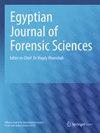在日惹的印尼成年人中,利用侧位脑片上鼻、鞍和眉间的角度测量来估计性别
IF 1.3
Q3 MEDICINE, LEGAL
引用次数: 0
摘要
背景性别估计给出了某人被分类为男性或女性的概率。由于颅骨的阻力和二态性,侧位脑电图分析可用于性别估计。已知眉间沟在男性和女性中具有二形特征,而鼻和鞍在许多颅骨测量中被广泛用作标准点。本研究旨在利用鼻-鞍-眉间角(NSG)、鞍-眉间角(SGN)和眉间角-鼻-眉间角(GNS)在侧位脑电图上建立一个方程,用于印度尼西亚日惹的印度尼西亚成年人的性别估计。结果从Gadjah Mada大学牙科医院的牙科记录中获取138例成人(20-40岁)数字侧位脑电图(108例用于性别估计方程;采用EzDent-i Vatech进行参数测量。采用独立t检验分析男女成人的角度差异。用判别函数分析确定了性别估计方程。男性和女性成人的NSG角平均值分别为9.64°±1.36°和11.21°±1.57°,SGN角平均值分别为54.65°±4.19°和60.83°±4.13°,GNS角平均值分别为118.33°±4.61°和109.84°±5.19°。独立t检验显示差异有统计学意义(p <0.05)。判别函数分析得到了利用NSG、SGN和GNS角度进行性别估计的方程,准确率高达75.9%,其中基于测试样本的性别估计准确率为70%。结论印尼成年男性的NSG角和SGN角小于成年女性,而GNS角大于成年女性。与准确性相关的是,研究结果表明,NSG、SGN和GNS角度对性别估计的判别功能不应推广到更广泛的人群。在未来的性别估计研究中,必须对更多的脑电图参数进行研究。本文章由计算机程序翻译,如有差异,请以英文原文为准。
Sex estimation using angular measurements of nasion, sella, and glabella on lateral cephalogram among Indonesian adults in Yogyakarta
Abstract Background Sex estimation gives the probability that someone is classified as a male or a female. Lateral cephalogram analysis can be used for sex estimation due to the resistance and dimorphism of the skull. Glabella has been known to have dimorphic characteristic in male and female, while nasion and sella have been widely used as a standard point in many craniometric measurements. This study aimed to develop an equation using nasion–sella–glabella (NSG), sella–glabella–nasion (SGN), and glabella–nasion–sella (GNS) angles on lateral cephalograms for sex estimation among Indonesian adults in Yogyakarta, Indonesia. Results A total of 138 adults (aged 20–40 years) digital lateral cephalograms were taken from the dental records at Universitas Gadjah Mada Dental Hospital (108 used to form the equation of sex estimation; 30 used to test the equation), and the parameters were measured with EzDent-i Vatech. An independent t -test was used to analyze the differences in the angles between male and female adults. The equation for sex estimation was determined using discriminant function analysis. The average measurements of the NSG angles in male and female adults were 9.64° ± 1.36° and 11.21° ± 1.57°, respectively, the SGN angles were 54.65° ± 4.19° and 60.83° ± 4.13°, respectively, whereas the GNS angles were 118.33° ± 4.61° and 109.84° ± 5.19°, respectively. The independent t -test revealed a significant difference ( p < 0.05) between male and female adults. Discriminant function analysis yielded an equation for sex estimation using the NSG, SGN, and GNS angles with an accuracy of up to 75.9%, with the accuracy of sex estimation based on the testing sample being 70%. Conclusion Based on the findings of this study, male Indonesian adults have a smaller NSG and SGN angles but a bigger GNS angle than female adults. Related to the accuracy, the study’s findings indicate that the discriminant function of NSG, SGN, and GNS angles for sex estimation should not be generalized in wider population. More cephalogram parameters must be investigated in future studies on sex estimation.
求助全文
通过发布文献求助,成功后即可免费获取论文全文。
去求助
来源期刊

Egyptian journal of forensic sciences
MEDICINE, LEGAL-
CiteScore
2.00
自引率
0.00%
发文量
51
审稿时长
17 weeks
期刊介绍:
Egyptian Journal of Forensic Sciences, the official publication of The International Association of Law and Forensic Sciences (IALFS), is an open access journal that publishes articles in the forensic sciences, pathology and clinical forensic medicine and its related specialities. The journal carries classic reviews, case studies, original research, hypotheses and learning points, offering critical analysis and scientific appraisal.
 求助内容:
求助内容: 应助结果提醒方式:
应助结果提醒方式:


